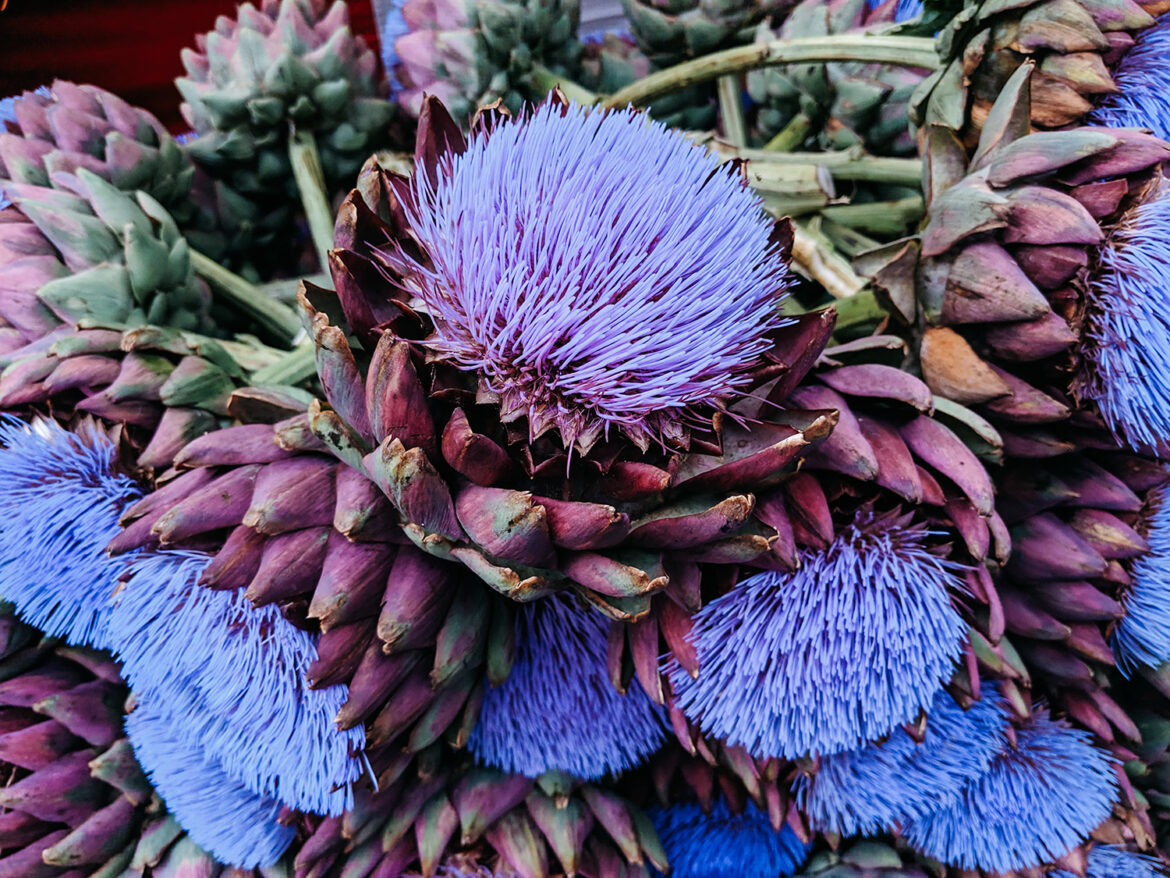Our summer issue is out now. Our regular contributor and gardening expert Hans Wieland shares the many benefits of Artichoke. Dive on in to find out more!
Globe Artichoke
The Graceful Edible Thistle
by Hans Wieland
“His memoir is a splendid artichoke of anecdotes, in which not merely the heart and leaves but the thistle as well are edible.” John Leonard
Italy is the country I most associate with eating artichokes. Very tender young artichokes raw in salads, or preserved in oil. Larger artichokes sautéed, stuffed, fried, breaded or with pasta. The artichoke or Carciofi is a prized delicacy in Italy. Grown in fields, called carciofaie, all across central and southern Italy and planted in bunches as part of their landscaping, or as hedges up and down the driveways that lead to their homes in Umbria.
…more than just an ornamental
We haven’t landscaped our driveway with artichokes yet, but we have always had artichokes and in years when we forgot to eat them, we enjoyed the flowers of this stunning and yet graceful plant just as much. Some gardeners grow them solely for their visual appeal as ornamental plants in a flower border. Not only do they have a unique architectural quality, but the arching leaves have a texture of their own. Whatever way you feel about eating it, the globe artichoke (Cynara scolymus) is a beautiful plant in any vegetable garden.
We love the interesting flavour and unique taste and cook them in salty water until soft. Dipping the leaves or scales in home-made aioli and scraping the small pads at the base of the scales with your teeth is a communal culinary experience, slow and sumptuous. The best part is the soft heart with a taste similar to asparagus. John Evelyn, writing his ‘Discourse on Salads’ in 1699, recommends the following – “the heads, being slit in quarters, first eaten raw, with oil, a little vinegar, salt and pepper gratefully recommends a glass of wine”. He also cooks the young artichokes in butter until crisp and serves them with parsley.
…and highly nutritious
Globe artichokes are also highly nutritious, low in fat, high in fibre and loaded with vitamins and minerals like vitamin C, vitamin K, folate, phosphorus and magnesium. They are prebiotic and have a high inulin content that feeds the good bacteria in the gut flora. This prohibits the growth of bad bacteria and has also been shown to stimulate the immune system.
“Globe artichokes are also highly nutritious, low in fat, high in fibre and loaded with vitamins and minerals…”
A very short history of the globe artichoke
The origin of globe artichokes is unknown. In the Arab world, they are known as ‘Ardi-Shoki’ which means ‘ground thorny’. One of the oldest cultivated vegetables grown in Sicily during the Greek period, the Greeks called them kaktos. In this period, the cultivated leaves and flower heads, which cultivation had already improved from the wild form, were eaten. The Romans received the plant from the Greeks and globe artichokes were cultivated in Naples around the middle of the ninth century. The plant was introduced to England in the 15th century and from there probably made its way to Ireland, where today they are still kind of a novelty and not widely available. The cultivation of globe artichokes is mainly concentrated in the nations along the Mediterranean basin, with Italy, Egypt and Spain the world’s main producers.
Growing globe artichokes for an early summer crop
The globe artichoke belongs to the Asteraceae family, which also includes plants like daisies, lettuce, chicory, dandelion, ragwort and sunflowers. Within the Asteraceae, globe, artichokes are considered to be ‘thistles’. Growing up to a height of 1.8 metres, and demanding a square metre of space, it effortlessly commands centre-stage. The largest globe is on top of the plant and the smaller ones grow beneath. It is at its eating prime as an immature flower. If not harvested, the buds (the edible part) will develop into deep-blue, thistle-like flowers. The edible matter are buds that form within the flower heads before the flowers come into bloom about six months after planting.
The buds then change to a coarse, not edible form and produce beautiful purple thistle-like flowers. Globe artichokes grow well in our mild climate, especially in seaside areas. They require a well-drained fertile soil and mulching with manure every spring helps to produce strong vigorous plants, ideally sheltered from strong winds. We grow our globe artichokes in a border in our vegetable garden. It’s slow to grow from seed, so best is to buy in plants or multiply from new shoots/suckers in spring, roots attached, from the outer section of established plants. Well known varieties are Green Globe, Romanesco and Violetta di Chioggia (purple).
Cutting back the flowering stalks at the base as soon as possible after harvesting the heads will promote the growth of strong suckers which will produce more in the following year. We haven’t encountered any problems and have experienced no pests or diseases. If you’re looking for something new for your vegetable garden, think globe artichokes. These prized vegetables add extra interest wherever they’re planted.
Hans Wieland works and teaches at Neantog Kitchen Garden School in Cliffony, Co.Sligo. neantog.com


